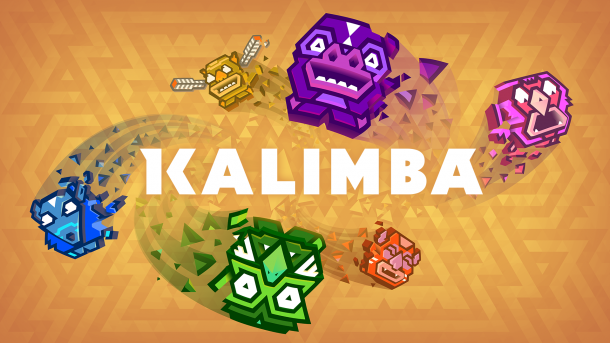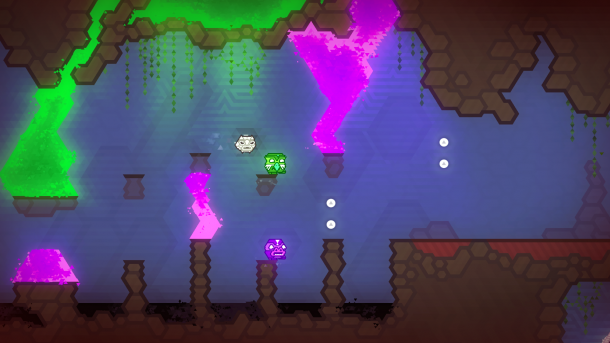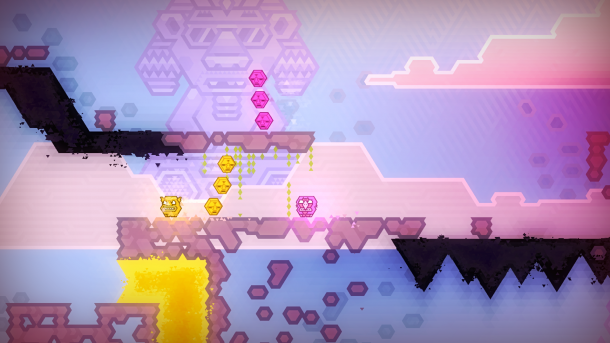
Platforming and puzzles are two game concepts that have been working together for a number of years to deliver satisfying gameplay. In Press Play’s Kalimba, totems work together in tandem to take these ideas and deliver a self co-op experience. The lovable totems of Kalimba look to put the pieces together in new satisfying ways, but they seem unable to stack up.
Players are tasked with getting two totem companions to the end of each level safely. On the way, players collect little tokens while stacking and separating the totems to maneuver through the level’s enemies, obstacles and terrain. Score for each level is derived from the number of tokens picked up minus the number of deaths experienced. Time is also considered but isn’t a factor for completeness, rather just for leaderboards.

Manipulation of the totems is the strength here, forcing players to split their focus between the two while controlling both simultaneously with the same button inputs. Jumping a gap with one might leave the other vulnerable or unable to continue safely. Missions sometimes feature pickups that alter a totem, making it grow in size and jump height or reversing its gravity. This further pushes a player’s focus, now calling on them to remember one totem’s special properties in cooperation with others default abilities. These pickups deliver some of the best challenges in Kalimba through their alteration of level design, but they also help highlight one of Kalimba’s greatest downfalls: player efficacy.
[pullquote_left]These pickups deliver some of the best challenges in Kalimba[/pullquote_left]
Level design is rigid and often feels mechanical in nature. Because of this, a player’s choice in movement and manipulation of the world is almost nonexistent, forcing players to follow the exact route of a level as envisioned by it’s designer. Schematically laid out levels aren’t automatically a bad thing for this type of game, but Kalimba actively uses it against the player’s enjoyment. Getting through a new challenge might not be too difficult, but after almost every one appears a section that requires precise timing of inputs, not skill to complete. This leads to numerous deaths and often frustration on what could be considered simple sections of a level. In turn, at the end of a level it never feels like going through it again and just tightening up a few moves could lead to a better score, but more of a relief that it’s over and you can move on to a new one.

Part of the problem stems from the game constantly introducing new pickups and alterations on those movesets without giving players enough time to acclimate themselves. A new ability will be introduced, used for two levels or so, and then abandoned for another, only to be used again down the line in a more challenging way than before. Building on mechanics is fundamental to any game but because of the small number of levels (24 single player and an additional 10 co-op) each unique mechanic feels more like a checklist to completing a level rather than an ability that through its manipulation can help you achieve your goal. A local co-op campaign is also available, giving two players each a set of totems to manipulate in tandem to solve puzzles. Any frustration that might arise from single player causes more strain here since players are now relying on one another to precisely manipulate their characters as well.
The redeeming factor for Kalimba is the game’s presentation. Bright neon colors adorn both the characters and environment, telegraphing perfectly to the player what they should be looking for and what they should be avoiding. Each different totem has a slew of facial expressions that alter themselves based on what is currently going on around them or happening to them. It seems silly, but its actually a nice way for players to better identify and feel the struggles of what is essentially two moving squares. Everything is constructed of geometric shapes that form beautiful lines, helping to give everything an overall cohesion that feels unlike any other game.
The story, delivered by a narrator named Hoebear, comes off as a little ham-fisted. The meta narrative is constantly breaking the fourth wall and pointing out that things are happening because it’s a game and a game needs game-like things to do. It comes off more comedic than annoying, but depending on the level of frustration at any given moment, it can easily cross that line.
Kalimba, in more than one way, feels split in two. On one totem sits an incredible presentation that’s sense of identity feels solid and unique with gameplay that asks the player to be always forward thinking. On the other sits needless additions to puzzles and levels that seem counter to the notion of players returning to previous levels. Kalimba is a mirror image of a platform puzzler, but its reflection lacks the gameplay and rewards that keep players interested in looking at it for long enough.
This review is based on a code for Xbox One sent to SideQuesting by the publisher.


No Comments